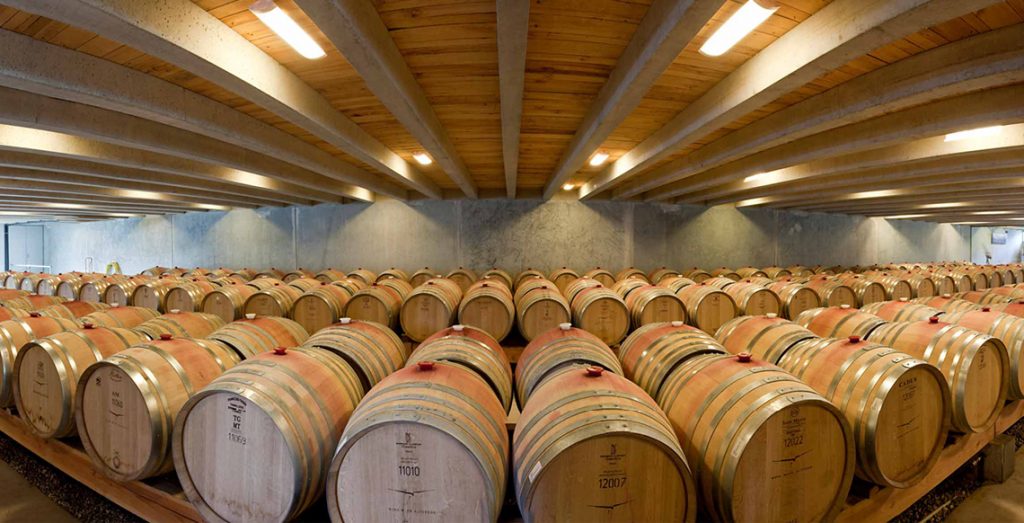
I recently published two articles about sugar in wine: One about why we call wines dry and the other about sweet wines. One of the other major components of wine, which is often misunderstood, is tannin. Tannin is a complex subject because unlike sugar it is perceived by people in many different ways depending on the type and level of tannin. In fact, in my wine Diploma we can’t just say a wine has “tannin”. We have to describe the type of tannin and try to link it back to its source. So what is tannin in wine?
Tannins are the astringent or mouth-coating feeling in your mouth as you drink a wine.
If you are a tea drinker you will know tannin as the astringent or slightly bitter feeling, especially evident in strongly brewed tea. Tannin adds substance or body to tea, which is effectively flavoured hot water.
Tannin acts in a similar way in wine. It provides substance or weight to a wine and counter balances the fruit flavours. There are two main sources of tannins:
- From the grape berries and sometime their stalks or stems;
- From any wood, usually oak, that the wine has come in contact with.
Tannin is often found in red wines because the grape juice is generally fermented with its skins to extract colour, and at the same time it also extracts tannin. Winemakers who want a higher level of tannin in their wine will use a higher fermentation temperature to extract more tannin from the skins, or sometimes include a proportion of stems/stalks from the grape bunches which also contain tannin. Although white wines are not normally fermented with their grape skins, they can still contain tannin through ageing in oak barrels, although the tannin levels are normally lower.
So how do we perceive tannin? It all depends on the type and level of tannin.
Tannin is a feeling or sensation that should compliment the other components of the wine.
Tannin derived from the gape itself is often described as astringent or “drying” on the palate, as if someone has sucked the moisture out of your mouth, often felt as you swallow the wine. Not surprisingly we refer to these as “drying tannins”. As mentioned, tannin can also be derived from the stems/stalks from the gape bunches and, depending on how ripe or mature they are, they can impart ‘green’ tannins which can be quite bitter or unpleasant, or ‘mature’ tannins which can be quite round and soft.
Tannin can also be extracted whilst the wine is stored in wood, usually oak, barrels. Wine in the barrel is sucked into the pores within the wood, thereby extracting tannin compounds along with flavours from the wood (more on the flavours in a later article). The longer the oak contact, and the newer the wood in the barrel(that is, whether it has been used before), the greater the level of tannin extraction. Winemakers who want less tannin will use older oak barrels where a lot of the tannin has already been extracted from the wood, or larger oak barrels where there lower ‘wine to oak’ contact. These tannins often provide a ‘back bone’ to the wine, and can be described as mouth filling, grippy or fine.

If you have ever tried a fruity red wine without tannin they can appear a bit one dimensional – lots of fruit flavours without much body or substance. This is quite common for young, easy-drinking wines that are not designed to age. As I have noted in previous articles, tannin is the main component that allows red wine to age. So in young wines tannins can appear to overpower the fruit flavours and be quite astringent and mouth filling. But as these types of wines age, the tannins soften to support the fruit flavours. In fact some wines, like premium Coonawarra Cabernet Sauvignon, can take up to 10 years before the tannins are soft enough to compliment the fruit…and they are great wines when they come into balance. A great example is “The Tally” from Balnaves of Coonawarra although many Coonawarra Cabernet Sauvignons have so much tannin when they’re young they can seem unapproachable.
Wines with higher tannin levels are generally food friendly. This is because the tannin cuts through the fat in food, reducing the fatty sensation while the fat, at the same time, reduces the perception of the tannin. That’s why a steak with good levels of marbling goes so well with an big Barossa Shiraz or Coonawarra Cabernet Sauvignon with good tannin levels. Yum-bunnies.
As you can see, tannin is quite a complex and misunderstood subject – I have just scratched the surface here. If you would like to find out more, head over to our events page. I am also happy to tailor corporate events to you needs and budget – perhaps a fun tasting to see how different people perceive tannin, and its impact on wines for your clients or team. Feel free to reach out to me here for an initial discussion.
In the meantime, if you need any tips or advice then feel free to reach out to me on our Facebook page and sign up to my mailing list to get access to our newsletter and wine specials.
Cheers,
Antony.

